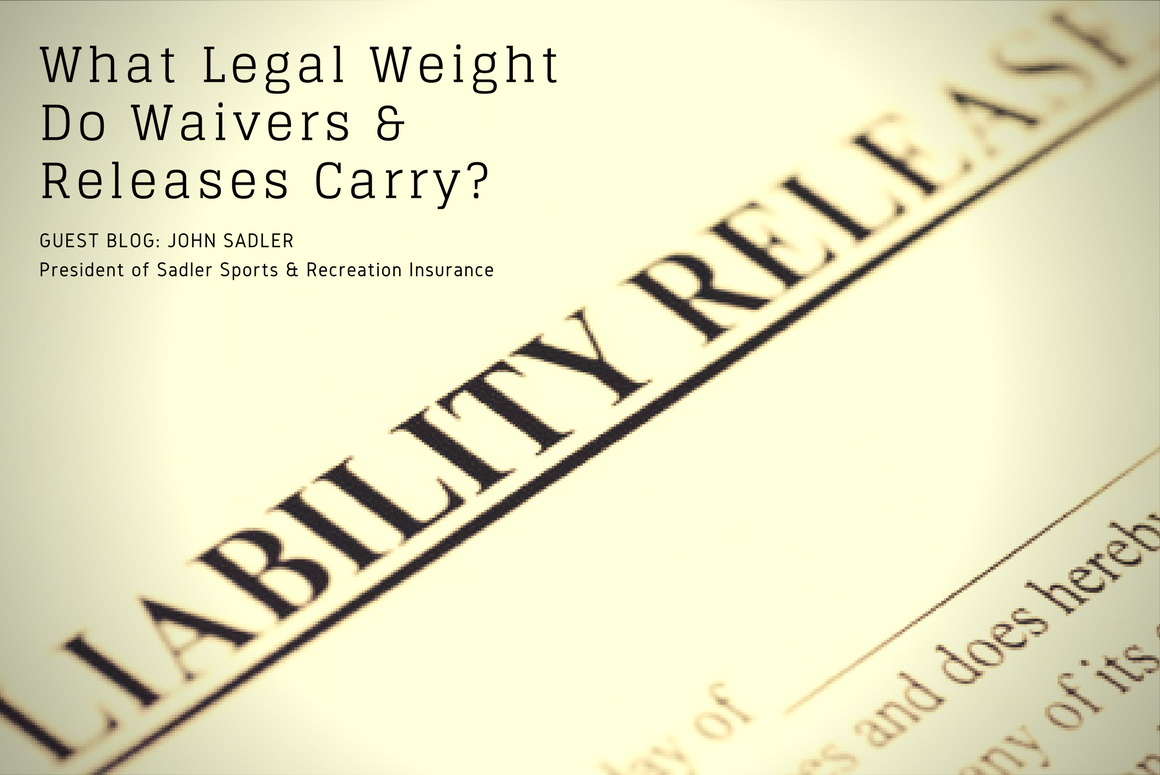 Guest blog by John M. Sadler.
Guest blog by John M. Sadler.
We’re pleased to introduce John M. Sadler as our guest blogger today. John, president of Sadler Sports & Recreation Insurance, is a youth sports coach, attorney, and sports insurance expert. He serves as the National Risk Manager for various national sports organizations and is on the Medical & Safety Advisory Committee of USA Baseball.
John’s blog and risk management materials are widely read by coaches, players, administrators, and parents, and emphasizes the prevention of claims and lawsuits through risk management.
Waivers and release agreements are documents participants are required to sign to take part in a variety of activities, which can be anything from an indoor rock climbing wall or horseback riding to travelling with a team to a tournament. It’s one of those documents that families tend to sign without reading and to which many organizations don’t pay enough attention. So, are they worth the paper they’re written on?
We interviewed claims managers from top sports insurance providers and attorneys specializing in cases involving waivers and releases. There’s a lot to know about the validity of these documents, but we’re going to focus on the basics in this article!
The Purpose of a Waiver/Release
A waiver/release is a protective agreement with two main purposes:
- A release from liability. Since waivers and releases are contracts, principles of contract law are used to excuse an organization for ordinary negligence; and
- Provide clear proof of warning of risks, inherent and otherwise, to participants or players.
 A release from liability should include any inherent risks resulting from ordinary negligence on the part of the organization. Examples of ordinary negligence are slip-and-fall injuries from water on the floor or lack of supervision resulting in a child being injured while roughhousing. Because the courts view waivers/releases as legal documents, it’s critical that they are well-drafted and reviewed by a legal professional with knowledge of recreation law.
A release from liability should include any inherent risks resulting from ordinary negligence on the part of the organization. Examples of ordinary negligence are slip-and-fall injuries from water on the floor or lack of supervision resulting in a child being injured while roughhousing. Because the courts view waivers/releases as legal documents, it’s critical that they are well-drafted and reviewed by a legal professional with knowledge of recreation law.
To be upheld in court, the waiver/release must meet two conditions:
- The injury was a result of a risk that was clearly listed in the document and from ordinary negligence.
- The wording in the document complies with the legislative or case law and does not violate public policy in the state where the organization is located or the injury occurs.
If these conditions are met, the lawsuit could be dismissed, which would significantly reduce legal defense costs. However, all action leading up to the dismissal will cost most organizations more than they can afford to pay out of pocket. Therefore, waivers/releases should never be considered ample protection, and organizations should seriously consider a General Liability Insurance policy to cover legal defense costs (for Canada, click here; for the United States, click here).
The waiver/release laws for adults and minors differ from state to state. Minors are not legally competent to enter into a binding contract, and, as a result, most minor waiver/releases include a parental signature. However, approximately 40 states will not allow a parent to waive a minor’s right to sue. Even so, the waiver/release should include an adequate risk warning and require a minor signature, as an assumption of risk on the part of the minor.
How to Draft a Waiver/Release
 A well-drafted waiver/release is one where every sentence is written with the intention of countering a potential court case. Here are some expert tips:
A well-drafted waiver/release is one where every sentence is written with the intention of countering a potential court case. Here are some expert tips:
- Use clear wording that is easily understandable – avoid legalese.
- Never include the waiver/release on a page with other forms – make sure that it is clearly visible to any participant/player reviewing and signing it.
- Avoid having multiple signatures on the same document. Each participant/player should sign a separate waiver/release document.
- The document should begin with “In consideration of being allowed to participate…” Parties in legally valid contracts are each to receive consideration, or something of value. In this case, the organization promises not to sue and the individual gets to participate or play.
- The full scope of possible injuries should be listed, and be sure to include “permanent disability or death.”
- Don’t limit the risks to games and practices or sports-based activities. Include non-sport outings and transportation if appropriate.
- Never try to disclaim responsibility for gross negligence or other outrageous conduct.
- Include the phrase “…to the fullest extent permitted by law…” with regard to negligence. The court may then strike any phrasing contrary to state law and keep intact the rest.
- Participants/players should sign a new waiver/release agreement before each registration period and for any new activities not covered in prior waivers/releases.
Instead of relying on a generic form, the best approach is to hire a professional who specializes in recreation law to customize an activity-specific and state-specific waiver/release agreement for your organization. An organization’s best approach is a well-written waiver/release agreement and a comprehensive General Liability insurance policy.
For more information about General Liability Insurance:
- What is liability insurance? (The Co-Operators – United States)
- Commercial General Liability Insurance in Canada (Intact Insurance – Canada)
- Frequently Asked Questions (Canadian Sports Insurance Brokers)
- General Liability Insurance for Sports & Recreation Organizations (Sadler Sports & Recreation Insurance)
To learn how ePACT can help you manage your organization’s waivers, consents, and releases, connect with our Sales Team or ask your Account Manager for more information.
Terms and Conditions
All content provided on this blog is for informational purposes only. The owner of this blog makes no representations as to the accuracy or completeness of any information on this site or found by following any link on this site. The owner will not be liable for any errors or omissions in this information nor for the availability of this information. The owner will not be liable for any losses, injuries, or damages from the display or use of this information. This policy is subject to change at any time.

